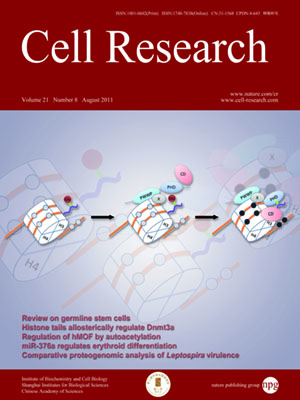
Volume 21, No 8, Aug 2011
ISSN: 1001-0602
EISSN: 1748-7838 2018
impact factor 17.848*
(Clarivate Analytics, 2019)
Volume 21 Issue 8, August 2011: 1182-1195
ORIGINAL ARTICLES
Modulations of hMOF autoacetylation by SIRT1 regulate hMOF recruitment and activities on the chromatin
Lu Lu*, Lei Li*, Xiang Lv, Xue-Song Wu, De-Pei Liu and Chih-Chuan Liang
National Laboratory of Medical Molecular Biology, Institute of Basic Medical Sciences, Chinese Academy of Medical Sciences & Peking Union Medical College, 5 Dong Dan San Tiao, Beijing 100005, China
Correspondence: Depei Liu,(liudp@pumc.edu.cn)
A wide variety of nuclear regulators and enzymes are subjected to acetylation of the lysine residue, which regulates different aspects of protein functions. The MYST family histone acetyltransferase, human ortholog of MOF (hMOF), plays critical roles in transcription activation by acetylating nucleosomal H4K16. In this study, we found that hMOF acetylates itself in vitro and in vivo, and the acetylation is restricted to the conserved MYST domain (C2HC zinc finger and HAT), of which the K274 residue is the major autoacetylation site. Furthermore, the class III histone deacetylase SIRT1 was found to interact with the MYST domain of hMOF through the deacetylase catalytic region and deacetylate autoacetylated hMOF. In vitro binding assays showed that non-acetylated hMOF robustly binds to nucleosomes while acetylation decreases the binding ability. In HeLa cells, the recruitment of hMOF to the chromatin increases in response to SIRT1 overexpression and decreases after knockdown of SIRT1. The acetylation mimic mutation K274Q apparently decreases the chromatin recruitment of hMOF as well as the global H4K16Ac level in HeLa cells. Finally, upon SIRT1 knockdown, hMOF recruitment to the gene body region of its target gene HoxA9 decreases, accompanied with decrease of H4K16Ac at the same region and repression of HoxA9 transcription. These results suggest a dynamic interplay between SIRT1 and hMOF in regulating H4K16 acetylation.
Cell Research (2011) 21:1182-1195. doi:10.1038/cr.2011.71; published online 19 April 2011
FULL TEXT | PDF
Browse 2346


